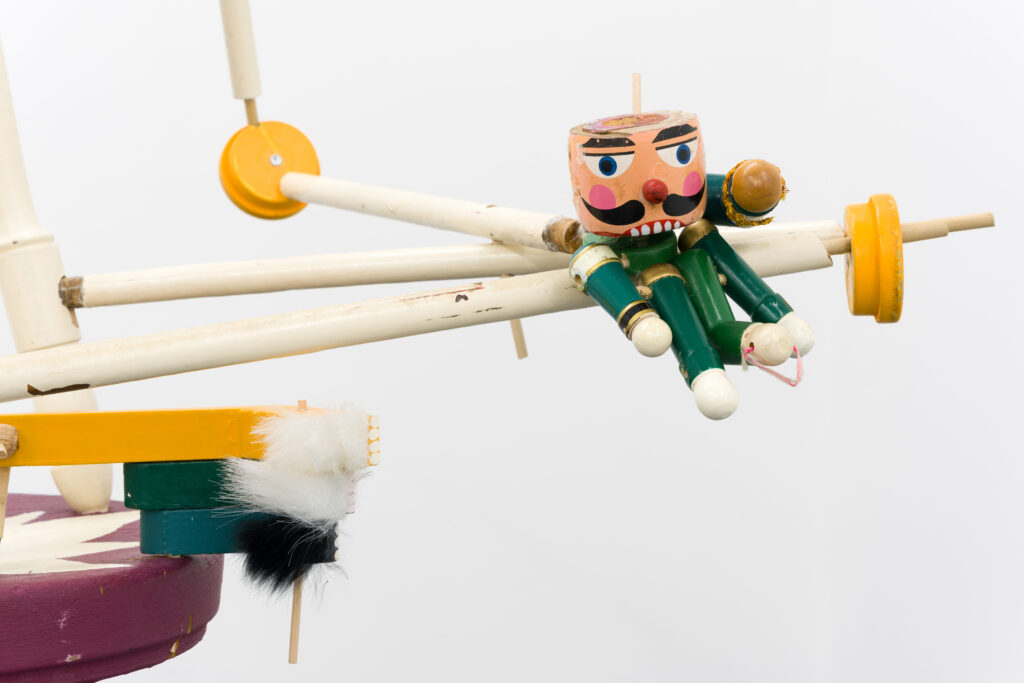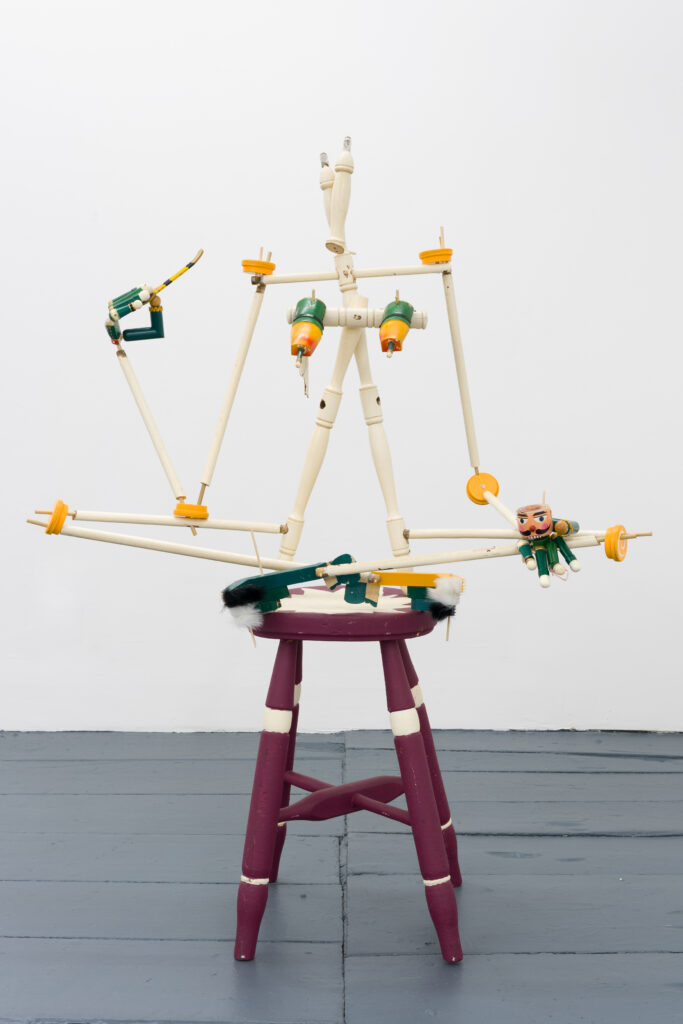
Artist Elizabeth Englander’s first solo museum show seeks Zen through the mundane. Annabel Keenan discovers Englander’s unusual sculptural take on spiritual body language.
“I’ve always been drawn to the figure, and, in a funny way, nutcrackers are one of the few figurative items in the home,” Elizabeth Englander tells me. We’re discussing the Brooklyn-based artist’s first museum solo show at the Aldrich Contemporary Art Museum in Ridgefield, Connecticut. In the exhibition, “Eminem Buddhism, Volume 3,” nutcrackers take center stage. An unexpected material, they offered a way for Englander to incorporate wood into her sculptural practice. “I knew I wanted to work with wood, but I didn’t have enough material,” she says. “Then, I found a nutcracker on the street in Red Hook.”

While having found a figure in the German toys, theirs is not the form Englander is interested in. Instead, she dismembers them, using the wooden pieces to create sculptures that draw inspiration from saints, gods, and goddesses of Jainism, Hinduism, and Buddhism and the intertwined sculptural traditions of these ancient belief systems. The exhibition’s title is a nod to this spiritual meaning and a playful reference to childhood stories Englander’s brother used to write. According to these tales, Buddha met the rapper Eminem and guided him through a spiritual conversion. Like the artist’s practice in general, the show is also a study of the figure and art history.
“There is something gruesome about taking nutcrackers apart, but it’s exactly how the figure was taught in art history,” Englander says. “In Paris in the 19th century, art schools had a relationship with medical schools and there was a lot of dissection that went on. Sometimes, in order to understand something, we need to take it apart.”
Like many who grew up with nutcrackers in their homes, Englander’s family had several. Along with other found and purchased examples, these family nutcrackers made their way into the artist’s work combined with pieces of furniture and toys.
“There is something gruesome about taking nutcrackers apart, but it’s exactly how the figure was taught in art history.”
Elizabeth Englander

“Nutcrackers are a bit of an anomaly,” she explains. “They’re not quite toys, even if we play with them, because they don’t really do anything.They feel like folk art objects, but they’re mass-produced. They’re kind of like family heirlooms and shrunken patriarchs, but they still have price tags from the Christmas Tree Shop on them. I’m interested in how the sentiment surrounding these objects accrues, whether that’s for me or for a complete stranger who owned the materials I use.”
Reconfiguring the nutcrackers, Englander gives them new meaning. They comprise the abstracted bodies of sacred forms from the artist’s studies of statuary icons in Asian religious art. In each one, a figural form is visible, but in the place of limbs are objects like chair legs and spindles. They also feature the parts of nutcrackers, dissected and rearranged.

As a group, the sculptures relate to one another much like the dozens of icons housed in medieval yogini temples, each representing different facets of Shakti, the central goddess worshiped in Hinduism. The representations of Shakti are different ages and have different appearances and attributes. Englander’s Yogini no. 10, for example, is based on the deity Chamunda, a form of Shakti that is a demon slayer (a metaphor for the slaying of personal demons) and wears a skulled garland. In Englander’s sculpture, nearly 20 nutcracker heads drape like a rope down the front of the figure, which is adorned with two red hats from Santa nutcrackers. In this work, the nutcrackers take the place of Chamunda’s skulls.
“These works have shifted my perspective,” Englander says. “Dismemberment is violent, and in the past, I worked with it as a negative metaphor and constant in the history of Western sculpture. But it’s also an important motif in Indian art. In Buddhist and Tantric iconography, decapitation can signify liberation because you’ve cut off your delusions. Working on these pieces revealed the positive aspect of decapitation as a metaphor for liberation.”

Englander has been making these seated yogini figures for three years, drawing on poses from Asian religious art and practice. Yoginis are minor deities, but the term also refers to female yoga practitioners. “I’ve used the yogini structure as a way to explore iconographies of various deities along with meditation poses, building a kind of spiritual body language vocabulary-slash-repertoire,” she says. “Normally, I wouldn’t stay this long on a single form or theme. There’s a logic to the yoginis, where the more you can explain how the different iterations of Shakti pervade everything, the more you get a sense of Shakti, which is essentially energy.”
While exploring these forms in her work, Englander began going to a Zen center and practicing Zen Buddhism. “I was drawn to Buddhist practice through the art,” she says. “I was interested in working with bronze and I watched Mellon talks by a Columbia scholar named Vidya Dehejia, who was discussing the famous Chola Indian bronzes like those depicting dancing Shiva. I had been working from Christian art, but these talks ignited an incipient interest in Asian sacred art that I trace back to a 2011 visit to the Leshan Giant Buddha in China.”
From Dehejia, Englander learned about Karaikkal Ammaiyar, a poet-saint who likely lived in the fifth century. Karaikkal Ammaiyar renounced her beauty to worship Shiva, playing music for her eternally. Depictions show Karaikkal Ammaiyar with an emaciated body, sometimes with fangs. The exhibition includes yoginis inspired by Karaikkal Ammaiyar, as well as Jinas and Bahubali. Jinas are the enlightened beings that spread Jainism and Bahubali is the heir of a dynastic war who is said to have meditated while standing for 12 years and renounced his power and possessions.
“In Buddhist and Tantric iconography, decapitation can signify liberation because you’ve cut off your delusions.”
Elizabeth Englander
“It was a big transition from reading the art history of Buddhism to practicing it, but as I began to practice, I started posing the figures in more accurate and comfortable ways,” says Englander. “I sometimes think of the yoginis as ‘learning to sit’ at the same time as I have been learning to sit.”
As she established her practice, Englander began incorporating zazen meditation poses into her yogini sculptures. She recognizes that with a practice steeped in history and research, not all visitors will have connections to her references, and some will likely have deeper ones than she does.
“I try to give as much information as possible, because the religious and art histories I work with are really rich,” she says. “One thing I hope people leave with is a feeling of the possibility for transformation. That’s what this body of work has been for me. I’m not the best Buddhist, but I hope that sharing my spiritual journey might open up possibilities for others.”
“Eminem Buddism, Volume 3” runs April 7–October 27 at the Aldrich Contemporary Art Museum.

